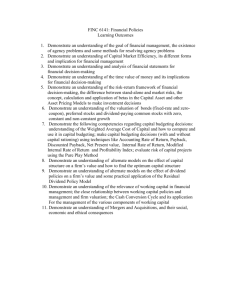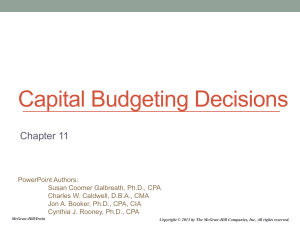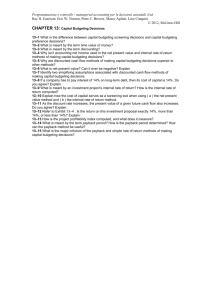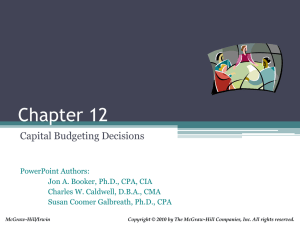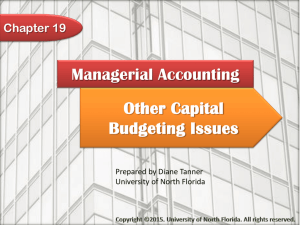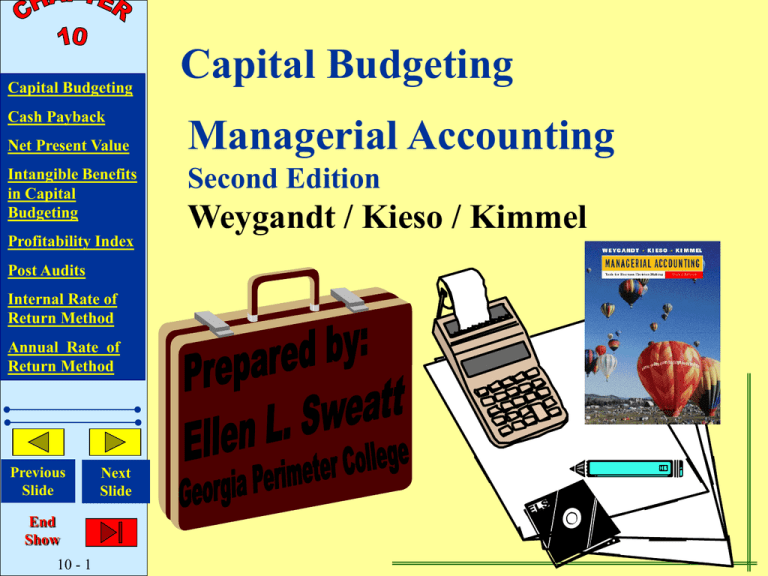
Capital Budgeting
Cash Payback
Net Present Value
Intangible Benefits
in Capital
Budgeting
Profitability Index
Post Audits
Internal Rate of
Return Method
Annual Rate of
Return Method
Previous
Slide
End
Show
10 - 1
Next
Slide
Capital Budgeting
Managerial Accounting
Second Edition
Weygandt / Kieso / Kimmel
Capital Budgeting
Capital Budgeting
Cash Payback
Net Present Value
Intangible Benefits
in Capital
Budgeting
Profitability Index
Post Audits
Internal Rate of
Return Method
Annual Rate of
Return Method
Previous
Slide
End
Show
10 - 2
Next
Slide
Capital Budgeting
Cash Payback
Net Present Value
Intangible Benefits
in Capital
Budgeting
Profitability Index
Post Audits
Internal Rate of
Return Method
Annual Rate of
Return Method
Previous
Slide
End
Show
10 - 3
Next
Slide
Capital Budgeting Is...
• The process of making capital
expenditure decisions in
business.
• Choosing among many capital
projects to find the one(s) that
will MAXIMIZE a company’s
return on its financial
investment.
Capital Budgeting Authorization
Capital Budgeting
Cash Payback
Net Present Value
Intangible Benefits
in Capital
Budgeting
Profitability Index
Post Audits
Internal Rate of
Return Method
Annual Rate of
Return Method
Previous
Slide
End
Show
10 - 4
Next
Slide
Capital Budgeting
Capital Budgeting
Cash Payback
Net Present Value
Intangible Benefits
in Capital
Budgeting
Profitability Index
Post Audits
Internal Rate of
Return Method
Annual Rate of
Return Method
Previous
Slide
End
Show
10 - 5
Next
Slide
Uses estimated Cash Inflows and
Outflows- not accrual-based income
statement numbers.
Illustration 10-2
Capital Budgeting
Capital Budgeting
Cash Payback
Net Present Value
Intangible Benefits
in Capital
Budgeting
Profitability Index
Post Audits
Internal Rate of
Return Method
Annual Rate of
Return Method
Previous
Slide
End
Show
10 - 6
Next
Slide
Cash Outflows:
• Initial investment
• Repairs and investment
• Increased operating cost
• Overhaul of equipment
Cash Inflows
• Sale of old equipment
• Increased cash received from
customers
• Reduced cash outflows related to
operating costs
• Salvage value of equipment when
project is completed.
Illustration 10-3
Data To Be Used In Following Examples
Initial investment
$130,000
Estimated useful life
10 years
Estimated salvage value
-0Estimated annual cash flows
Cash inflow from customers
$200,000
Cash outflows for operating costs
176,000
Net annual cash inflow
$ 24,000
Illustration 10-4
Capital Budgeting
Cash Payback
Net Present Value
Intangible Benefits
in Capital
Budgeting
Profitability Index
Post Audits
Internal Rate of
Return Method
Annual Rate of
Return Method
Previous
Slide
End
Show
10 - 8
Next
Slide
Cash Payback Technique
A capital budgeting technique
that identifies the time period
required to recover the cost of
a capital investment from the
annual cash inflow produced
by the investment.
Cost of
Capital
Investment
Net Annual
Cash Inflow
=
The shorter the payback
period, the better.
Cash
Payback
Period
Illustration 10-4
Cash Payback Technique
Capital Budgeting
Cash Payback
Net Present Value
Intangible Benefits
in Capital
Budgeting
Cost of
Capital
Investment
Net Annual
Cash Inflow
=
Cash
Payback
Period
Profitability Index
Post Audits
Internal Rate of
Return Method
Annual Rate of
Return Method
Previous
Slide
End
Show
10 - 9
Next
Slide
$130,000 $24,000 = 5.42 years
Cash Payback
Capital Budgeting
Advantages:
Net Present Value
May be critical factor if company
Intangible Benefits
in Capital
needs a fast turnaround of money.
Budgeting
Profitability Index
Easy to compute and understand.
Post Audits
Internal Rate of
Disadvantages:
Return Method
Annual Rate of
Ignores
profitability
of
project.
Return Method
Ignore time value of money.
Cash Payback
Previous
Slide
End
Show
10 - 10
Next
Slide
Net Present Value
Capital Budgeting
Cash Payback
Net Present Value
Intangible Benefits
in Capital
Budgeting
Profitability Index
Post Audits
Internal Rate of
Return Method
Annual Rate of
Return Method
Previous
Slide
End
Show
10 - 11
Next
Slide
The difference that results
when the original capital
outlay is subtracted from the
discounted cash inflows.
Net Present Value Method
Capital Budgeting
Cash Payback
Net Present Value
Intangible Benefits
in Capital
Budgeting
Profitability Index
Post Audits
Internal Rate of
Return Method
Annual Rate of
Return Method
Previous
Slide
End
Show
10 - 12
Next
Slide
A method used in capital
budgeting in which cash
inflows are discounted to their
present value and then
compared to the capital
outlay required by the
investment.
Discounted Cash Flow Technique
Capital Budgeting
Cash Payback
Net Present Value
Intangible Benefits
in Capital
Budgeting
Profitability Index
Post Audits
Internal Rate of
Return Method
Annual Rate of
Return Method
Previous
Slide
End
Show
10 - 13
Next
Slide
A capital budgeting technique
that considers both the
estimated total cash inflows
from the investment and the
time value of money.
Illustration 10-5
Net Present Value Criteria
Capital Budgeting
Cash Payback
Net Present Value
Intangible Benefits
in Capital
Budgeting
Profitability Index
Post Audits
Internal Rate of
Return Method
Annual Rate of
Return Method
Previous
Slide
End
Show
10 - 14
Next
Slide
Net Present Value
Annual cash inflows are $24,000 for all ten years.
Illustration 10-6
PV at 12%
Discount factor for annuity of $1
for 10 periods
5.65022
Present value of cash flows:
$24,000 x 5.65022
$135,605
The analysis of the proposal by the Net
Present Value method is:Illustration 10-7
Present value of cash flows:
Capital investment
Net present value
12%
$135,605
130,000
$ 5,605
The proposed capital expenditure is acceptable at the 12%
required rate of return because the NPV is positive.
Choosing A Discount Rate
Capital Budgeting
Cash Payback
Net Present Value
Intangible Benefits
in Capital
Budgeting
Profitability Index
Post Audits
Internal Rate of
Return Method
Annual Rate of
Return Method
Previous
Slide
End
Show
10 - 16
Next
Slide
•A company uses a discount rate
that is equal to its cost of capital.
•The cost of capital is a weighted
average of the rates paid on
borrowed funds and funds from
investors in the company’s stock.
•A discount rate has two elements:
•a cost of capital element
•a risk element.
•Companies often assume the risk
element is zero.
Cost of Capital
Capital Budgeting
Cash Payback
Net Present Value
Intangible Benefits
in Capital
Budgeting
Profitability Index
Post Audits
Internal Rate of
Return Method
Annual Rate of
Return Method
Previous
Slide
End
Show
10 - 17
Next
Slide
The average rate of return that
the firm must pay to obtain
borrowed and equity funds.
Net Present Value Assumptions
Capital Budgeting
Cash Payback
Net Present Value
Intangible Benefits
in Capital
Budgeting
Profitability Index
Post Audits
Internal Rate of
Return Method
Annual Rate of
Return Method
Previous
Slide
End
Show
10 - 18
Next
Slide
•All cash flows come at the end
of each year.
•All cash flows are immediately
reinvested in another project
that has a similar return.
•All cash flows can be predicted
with certainty.
Intangible Benefits
Capital Budgeting
Cash Payback
Net Present Value
Intangible Benefits
in Capital
Budgeting
Profitability Index
Post Audits
Internal Rate of
Return Method
Annual Rate of
Return Method
Previous
Slide
End
Show
10 - 19
Next
Slide
Increased quality
Safety
Employee loyalty
To avoid rejecting projects that should
be accepted, two possible approaches
are suggested:
– Calculate NPV ignoring intangible
benefits and if NPV is negative, ask if
intangible benefits are worth at least
the negative NPV.
– Project rough, conservative estimates
of the value of the intangible benefits
and include those in NPV calculation.
Mutually Exclusive Projects
Capital Budgeting
Illustration 10-16
Cash Payback
Net Present Value
Intangible Benefits
in Capital
Budgeting
Profitability Index
Post Audits
Internal Rate of
Return Method
Annual Rate of
Return Method
Previous
Slide
End
Show
10 - 20
Next
Slide
Initial investment
Net annual cash inflows
Salvage value
Net present value
Project A
$40,000
10,000
5,000
18,112
Project B
$90,000
19,000
10,000
20,574
10 year life
12% discount
rate
Mutually Exclusive Projects
Capital Budgeting
Cash Payback
Net Present Value
Intangible Benefits
in Capital
Budgeting
Profitability Index
Post Audits
Internal Rate of
Return Method
Annual Rate of
Return Method
Previous
Slide
End
Show
10 - 21
Next
Slide
Revised investment information for the
two projects is:
Illustration 10-18
Initial investment
Net annual cash inflows
Salvage value
Present value of cash flows:
($10,000 x 5.65022) + ($5,000 x .32197)
($19,000 x 5.65022) + ($10,000 x .32197)
Project A
$40,000
10,000
5,000
Project B
$90,000
19,000
10,000
58,112
110,574
Profitability Index
Capital Budgeting
Cash Payback
Net Present Value
Intangible Benefits
in Capital
Budgeting
Profitability Index
Post Audits
Internal Rate of
Return Method
Annual Rate of
Return Method
Previous
Slide
End
Show
10 - 22
Next
Slide
A method of comparing
alternative projects that takes
into account:
• the size of the investment
• its discounted future cash
flows.
Illustration 10-17
Present
Value of
Cash Flows
Initial
Investment
=
Profitability
Index
Profitability Index
Capital Budgeting
Cash Payback
Net Present Value
Intangible Benefits
in Capital
Budgeting
Profitability Index
Post Audits
Internal Rate of
Return Method
Annual Rate of
Return Method
Revised investment information for the
two projects is:
Illustration 10-18
Initial investment
Net annual cash inflows
Salvage value
Present value of cash flows:
($10,000 x 5.65022) + ($5,000 x .32197)
($19,000 x 5.65022) + ($10,000 x .32197)
End
Show
10 - 23
Next
Slide
Project B
$90,000
19,000
10,000
58,112
110,574
Illustration 10-19
Profitability Index = Present Value of Cash Flows
Initial Investment
Project A
Previous
Slide
Project A
$40,000
10,000
5,000
Project B
$58,112 = 1.45 $110,574 = 1.23
$40,000
$90,000
Project A is better because it has the higher
profitability index.
Post-audit
Capital Budgeting
Cash Payback
Net Present Value
Intangible Benefits
in Capital
Budgeting
Profitability Index
Post Audits
Internal Rate of
Return Method
Annual Rate of
Return Method
Previous
Slide
End
Show
10 - 24
Next
Slide
A thorough evaluation of how
well a project’s actual
performance matches the
projections made when the
project was proposed.
Illustration 10-21
Internal Rate of Return
Capital Budgeting
Cash Payback
Net Present Value
Intangible Benefits
in Capital
Budgeting
Profitability Index
Post Audits
Internal Rate of
Return Method
Annual Rate of
Return Method
Previous
Slide
End
Show
10 - 25
Next
Slide
Internal Rate of Return
Capital Budgeting
Cash Payback
Net Present Value
Intangible Benefits
in Capital
Budgeting
Profitability Index
Post Audits
Internal Rate of
Return Method
Annual Rate of
Return Method
Previous
Slide
End
Show
10 - 26
Next
Slide
The rate that will cause the
present value of the proposed
capital expenditure to equal
the present value of the
expected annual cash inflows.
Internal Rate of Return Method
Capital Budgeting
Cash Payback
Net Present Value
Intangible Benefits
in Capital
Budgeting
Profitability Index
Post Audits
Internal Rate of
Return Method
Annual Rate of
Return Method
Previous
Slide
End
Show
10 - 27
Next
Slide
A method used in capital
budgeting that results in
finding the interest yield of
the potential investment.
Capital Budgeting
Cash Payback
Net Present Value
Intangible Benefits
in Capital
Budgeting
Profitability Index
Post Audits
Internal Rate of
Return Method
Annual Rate of
Return Method
Previous
Slide
End
Show
10 - 28
Next
Slide
Annual Rate of Return Method
The determination of the
profitability of a capital
expenditure by dividing
expected annual net income
by the average investment
Illustration 10-23
Annual Rate of Return Method
Capital Budgeting
Cash Payback
Net Present Value
Intangible Benefits
in Capital
Budgeting
Profitability Index
Post Audits
Internal Rate of
Return Method
Annual Rate of
Return Method
Illustration 10-24
Sales
Less: Cost and expenses
Manufacturing costs
Depreciation expense ($130,000 5)
Selling and administrative expenses
Income before income taxes
Income tax expense
Net income
$200,000
$132,000
26,000
22,000
180,000
20,000
7,000
$ 13,000
Illustration 10-25
Average Investment
Previous
Slide
End
Show
10 - 29
Original Investment + Value at end of usefu1 life
2
Next
Slide
$13,000 $65,000 = 20%
Capital Budgeting
COPYRIGHT
Cash Payback
Net Present Value
Copyright © 2002, John Wiley & Sons, Inc. All rights reserved.
Reproduction or translation of this work beyond that permitted in
Section
117 of the 1976 United States Copyright Act without the
Profitability
Index
written permission of the copyright owner is unlawful.
Post express
Audits
Request
Internal
Rate of for further information should be addressed to the
Return Method
Permissions Department, John Wiley & Sons, Inc. The purchaser
Annual Rate of
may
make back-up copies for his/her own use only and not for
Return
Method
distribution or resale. The Publisher assumes no responsibility
for errors, omissions, or damages, caused by the use of these
programs or from the use of the information contained herein.
Intangible Benefits
in Capital
Budgeting
Previous
Slide
End
Show
10 - 30
Next
Slide


